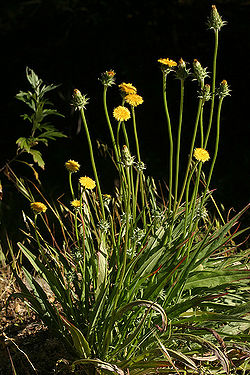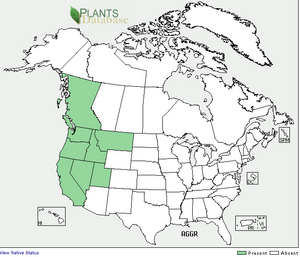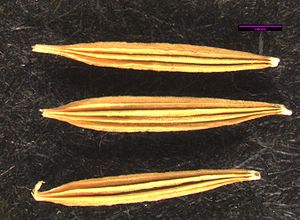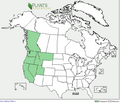Agoseris grandiflora
common name: bigflower agoseris, grassland agoseris, goat-chicory, grand mountain dandelion, large-flower false-dandelion, Mountain Dandelion, Shortbeak Agoserisor sometimes California dandelion, is a herbaceous flowering plant in the Asteracae family.
Abbreviation Code (Codon): AGGR
Contents
Synonyms
- Agoseris laciniata
- Stylopappus grandiflorus
- Agoseris cinerea
- Agoseris grandiflora (Nutt.) Greene var. intermedia
- Agoseris grandiflora (Nutt.) Greene var. plebeia
- Agoseris intermedia
- Agoseris laciniata
- Agoseris marshallii
- Agoseris obtusifolia
- Agoseris plebeia
- Stylopappus grandiflorus Nutt.[1]
Taxonomy
- Kingdom Plantae – Plants
- Subkingdom Tracheobionta – Vascular plants
- Superdivision Spermatophyta – Seed plants
- Division Magnoliophyta – Flowering plants
- Class Magnoliopsida – Dicotyledons
- Subclass Asteridae
- Order Asterales
- Family Asteraceae – Aster family
- Genus Agoseris Raf. – agoseris
- Species Agoseris grandiflora (Nutt.) Greene – bigflower agoseris
Description
Scapose and stout perennial, 20-70 cm tall, with basal, oblanceolate to broadly linear pinnatifid leaves typically 10-40 cm. long and 1-3 cm. wide. The juice milky and hairy when young, becoming hairless with age. Large, yellow, multi-flowered head appearing almost as a single flower such as in the common dandelion. This head is about 1.5-4 cm. high, its outer bracts broad and short, the inner narrower and elongate; corollas all ligulate. Produces fruits with achene body 4-7 mm. long, tapering to a slender beak 2-4 times as long. [2] [3]Look-alikes: Microseris borealis, Agoseris glauca (Pursh) Raf. var. laciniata, Agoseris glauca, and Taraxacum officinale.
Bloom Period
May-August [2]
Distribution
British Columbia to California; Nevada, Utah, Idaho, and Montana. [4]
Habitat
Meadows and other open places in the lowlands and at moderate elevations in the mountains, often in dry areas. [2]
Uses
Was this used for pinole?
Propagation
Seeds are collected by cutting the inflorescence after the pappus has expanded. Seed is wind disseminated and shatters soon after ripening. Seed is stored in paper bags at room temperature until cleaned. For small amounts, the pappus can be removed by hand. With larger amounts, a hammermill is effective for removing the pappus. Seed is then cleaned with an air column separator or air screen equipment. Cleaned seed is stored in controlled conditions at 40 degrees F. and 40% relative humidity.
Propagation Protocol from Native Plant Network
Seed
Seed sample from: 2010
Average Measurement: 5.2 x 0.7 x 0.7
Measurement Range: L: 4.6 - 6, W: 0.5 - 0.9, D: 0.5 - 0.9
Features
Shape: Seeds tapering to a beak 2-3 times as long as the body of the seed.
Color: Seeds pale brown with white, glossy hilum.
Additional Structures: Pappus white, and downy.
Surface: Seed body deeply longitudinally grooved. Ridges are finely toothed. Seed slightly glossy.
Latitudinal Cross Section: elliptical ![]()
Longitudinal Cross Section: obovate ![]()
Basic Explanations and Assumptions:
The dimensions for the seeds are length x width x depth. The location of the hilum is used as the base of the seed, and the length is measured from hilum to the opposite apex. Where a style is present, the length is measured from the hilum to the bottom of the style. Width is measured at a right angle to the length at the widest part. Depth is measured at a right angle to the intersection of height and width lines.
Measurements included are the mean average for each measurement of ten separate seeds.
All measurements in millimeters unless otherwise noted.






